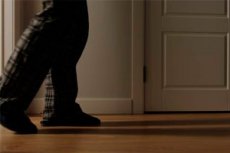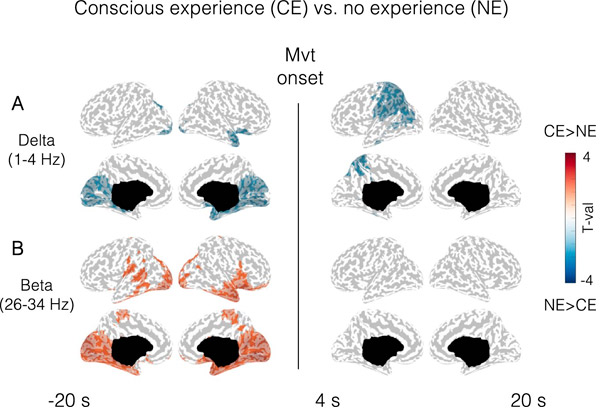Nye publikasjoner
Parasomni: Hva skjer i hjernen til den som går i søvne?
Sist anmeldt: 02.07.2025

Alt iLive-innhold blir gjennomgått med medisin eller faktisk kontrollert for å sikre så mye faktuell nøyaktighet som mulig.
Vi har strenge retningslinjer for innkjøp og kun kobling til anerkjente medieområder, akademiske forskningsinstitusjoner og, når det er mulig, medisinsk peer-evaluerte studier. Merk at tallene i parenteser ([1], [2], etc.) er klikkbare koblinger til disse studiene.
Hvis du føler at noe av innholdet vårt er unøyaktig, utdatert eller ellers tvilsomt, velg det og trykk Ctrl + Enter.

Forskere ved Nederlands institutt for nevrovitenskap har begynt å studere et komplekst spørsmål: hva skjer i hjernen til en person som kan være «fastlåst» mellom søvn og våkenhet?
De fleste av oss tenker på en søvngjenger som en som går ubevisst rundt med lukkede øyne og utstrakte armer. I virkeligheten går søvngjengere vanligvis rundt med åpne øyne og er i stand til å samhandle med omgivelsene. Søvnforskere kaller denne unormale søvnatferden « parasomni », som kan omfatte enkle handlinger som å sette seg opp i sengen og se forvirret ut, men også mer komplekse handlinger som å stå opp av sengen, bevege seg rundt eller skrike med et skremt uttrykk.
Selv om denne typen parasomni er vanligere hos barn, opplever omtrent 2–3 % av voksne det regelmessig. Parasomnier kan være plagsomme for både den sovende og sengepartneren. «De som lider av dette kan skade seg selv eller andre under episodene og senere skamme seg dypt over handlingene sine», forklarer Francesca Siclari, direktør for Dream Lab.
Studerer parasomnier i laboratoriet Siclari og teamet hennes gjennomførte studien for å bedre forstå hva som skjer i hjernen under parasomnier. «Tidligere trodde man at drømmer bare forekom i løpet av én søvnfase: REM-søvn. Nå vet vi at drømmer også kan forekomme i andre stadier. De som opplever parasomnier under ikke-REM-søvn rapporterer noen ganger drømmelignende opplevelser, og andre ganger virker de helt ubevisste (dvs. på autopilot).»
For å forstå hva som driver disse forskjellene i opplevelser, undersøkte Siclari og teamet hennes opplevelsene og hjerneaktivitetsmønstrene til parasomnipasienter under ikke-REM-søvn.
Det er ikke lett å måle hjerneaktivitet under en parasomni-episode. Pasienten må sovne inn, oppleve episoden og registrere hjerneaktivitet under bevegelse.
«Det finnes svært få studier akkurat nå som har overvunnet dette. Men takket være de mange elektrodene vi bruker i laboratoriet og noen spesifikke analyseteknikker, kan vi nå få et veldig rent signal selv når pasienter beveger seg», forklarer Siclari.
Siclaris team kan indusere en parasomni-episode i laboratoriet, men det krever to påfølgende opptak. Under det første opptaket sover pasienten normalt. Deretter er det en natt hvor pasienten bare får sove om morgenen etter en søvnløs natt.
Under denne opptaket, når pasienten går inn i en dyp søvnfase, blir de utsatt for en høy lyd. I noen tilfeller resulterer dette i en episode med parasomni. Etter episoden blir pasienten spurt om hva de tenkte på.
I 56 % av episodene rapporterte pasientene at de hadde drømmer. «Ofte involverte dette en forestående katastrofe eller fare. Noen trodde taket skulle rase sammen. En pasient trodde han hadde mistet barnet sitt, lette etter ham i sengen, reiste seg opp i sengen for å redde marihøner som skled nedover veggen og falt», forklarer Siclari.
«I 19 % av tilfellene opplevde pasientene ingenting og våknet rett og slett opp og oppdaget at de gjorde noe som om de var i transe.» En annen liten andel rapporterte at de opplevde noe, men ikke kunne huske hva.

Basert på disse tre kategoriene sammenlignet Siclaris team den målte hjerneaktiviteten og fant klare paralleller. «Sammenlignet med pasienter som ikke opplevde noe, hadde pasienter som drømte under episoden hjerneaktivitet som lignet på den man så under drømmer, både før og under episoden», legger Siclari til.
«Om en pasient er helt bevisstløs eller drømmer, ser ut til å avhenge av pasientens tilstand på det tidspunktet. Hvis vi aktiverer hjernen når de sannsynligvis allerede drømmer, ser det ut til at de kan «gjøre noe» ut fra den aktiveringen, mens når hjernen deres i stor grad er «deaktivert», skjer enkle handlinger uten ubehag.»
«Interessant nok nevner pasienter nesten aldri lyden som utløste parasomni-episoden, men snakker om en annen forestående fare. Jo høyere vi lager lyden, desto større er sjansen for å utløse en episode.»
Neste steg Selv om dette bare er et første steg, er det mye rom for oppfølgingsforskning. «Ideelt sett ville det vært flott å sette opp et søvnregistreringssystem for flere hjemme, der de også kan ha mer komplekse og hyppige episoder. Vi ønsker også å gjenta denne typen forskning på personer som opplever parasomnier under REM-søvn. Ved å måle hjerneaktivitet som denne studien håper vi etter hvert å bedre forstå hvilke nevrale systemer som er involvert i ulike typer parasomnier», sier Siclari.
Selv om det gjenstår mye forskning, er Siclari trygg på at arbeidet hennes kan gi verdifull innsikt. «Disse erfaringene er svært reelle for pasienter, og mange har allerede følt lettelse over å dele dem med oss. I likhet med tidligere studier hjelper studien vår dem med å forstå hva de går gjennom, noe som er pedagogisk verdifullt.»
«I tillegg kan arbeidet vårt bidra til utviklingen av mer spesifikke medikamentelle tiltak i fremtiden. Parasomnier behandles ofte med uspesifikke søvnmedisiner, som ikke alltid er effektive og kan ha bivirkninger. Hvis vi kan identifisere hvilket nervesystem som fungerer unormalt, kan vi kanskje etter hvert prøve å utvikle mer spesifikke behandlinger.»
Studien er publisert i tidsskriftet Nature Communications.
